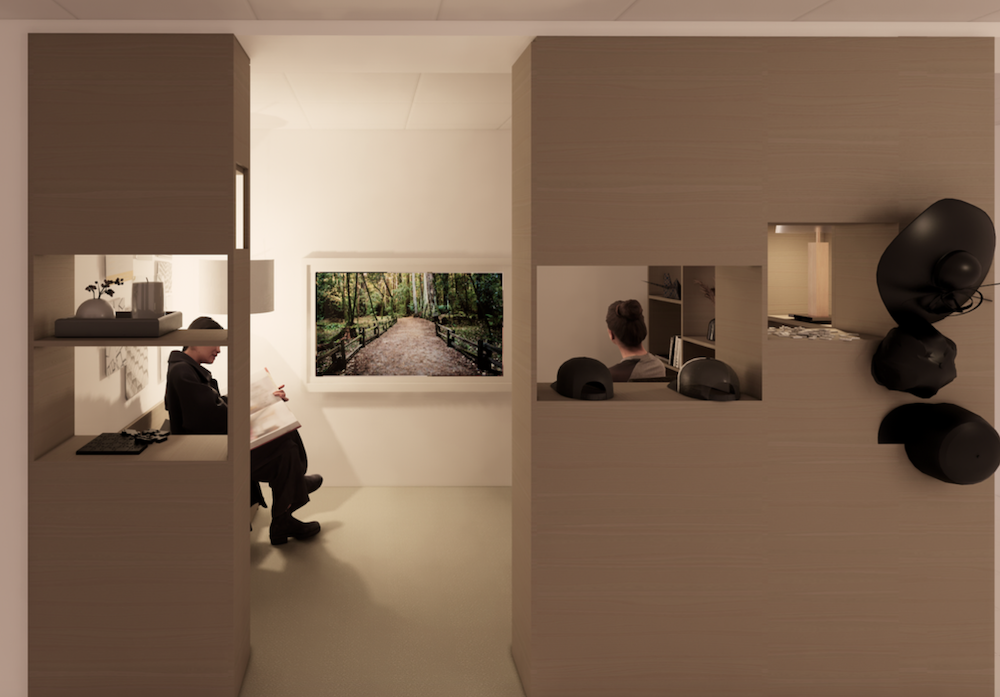By Sloane Airey
Architects and designers are increasingly exploring how their work can improve outcomes and quality of life for older adults with dementia.
“Because people are living longer, we are seeing more people who are living with some kind of mild cognitive or even more severe cognitive impairment,” Cynthia Shonaiya, a principal with Baltimore-based architecture firm Hord Coplan Macht (HCM), told Memory Care Business. “So we are seeing that senior living communities that previously would not have had specialized areas for people who are suffering from cognitive impairments or memory impairments are now designing specialized areas and amenities for memory care.”
This reflects trends worldwide to explore alternative design options such as small-house models. RLPS Architects Senior Designer Max Winters told MCB, “The idea there is that, especially with a lot of the symptoms and the things that dementia changes about how you perceive and how you act, that a smaller setting with fewer people that’s quieter, that’s just at the right scale feels better.”
Design innovations and best practices – including some that may not be intuitive – are steadily improving the quality of memory care, but architects and operators also are facing steep challenges in enhancing environments, given financial limitations, staffing constraints, and other obstacles.
Loss, Loops and Lights
No matter the size of memory care facilities, experts say design can make the environment better for residents. And the best designs are not necessarily what people might expect.
“A common myth is that environments for older adults, especially those facing memory loss, should be extremely simple,” said Dr. Upali Nanda, Global Practice Director and Partner at the Dallas-based architecture firm HKS. “But the reverse is true – an optimal amount of complexity helps develop cognitive health and develop associations.”
One design technique that experts touted is integrating natural elements that draw in multiple senses.
“Having natural elements, whether it’s wood, or plants, access to nature, all of those things we find are comforting and familiar to residents,” said Shonaiya. She cited walls of water, fountains, and plants that attract butterflies as natural elements HCM has featured in designs so far.
NYC-headquartered design firm Perkins Eastman has also added “enrichment environment” details to a Florida living facility like modified kitchens for residents to mix up meals and encourage socializing, Associate Principal Hillary DeGroff told MCB.
Another popular and time-tested tactic involves building layouts with looping hallways or spoke-in-wheel configurations. These floor plans allow residents to wander without getting lost while also allowing staff to keep an eye on them.
“We find that wandering and movement is very common with those with these impairments,” said Shonaiya, adding that looping hallways mean, “you don’t suddenly come to the end of the corridor and not know what to do.”
Nanda from HKS added that these design layouts can also improve staffing efficiency by cutting down on unnecessary footsteps.
At the same time, Winters said that technological advances like fall alerts mean today’s staff members can monitor residents without needing a panopticon line of sight.
 HKS HKS
HKS HKS“That’s going to free up the built environment to be more focused on social connection, connection to the environment, connection to the landscape,” he said. He advocates for small houses that help residents with dementia live in quieter, less confusing environments.
One simple but significant technological-based design choice is lighting. Senior housing communities nationwide are exploring daylight-timed LED lighting to harness the power of people’s circadian rhythms.
“There is a phenomenon called sundowning, where residents can actually get more agitated towards the end of the day,” Shonaiya explained. “So by utilizing soft technology like this, it helps in regulating these personal rhythms throughout the day.”
Trifecta of challenges
A trifecta of senior housing woes can affect providers’ ability to pursue memory care design innovations. Those challenges are staffing shortages, budget shortages and the as-yet-incurable progression of dementia.
“… These days of high interest rates, and high construction costs and the high labor expenses, how can we continue to provide these environments for the growing number of people that need them at an affordable cost?” asked Shonaiya.
Still, all four experts who spoke with Memory Care Business echoed the same desire to one day be able to create (and fund) a state-of-the-art memory care facility that is truly integrated into communities instead of standing apart from them. Such village models are already underway in the Netherlands and are being tested in limited ways across the United States.
“If money was no obstacle, individuals with dementia would never need to leave their families and communities,” said DeGroff with Perkins Eastman. “The care that they need would be integrated into their homes. The staff and caregivers needed to support this would be well-paid and well-respected, resulting in high rates of job satisfaction and low turnover.”
Winters described how memory care communities can be built affordably in rural areas (“little Shaker villages”) or urban areas (“two small houses”) that are served centrally by staff and feature amenities like restaurants, art rooms, and classrooms shared with the community.
“At the end of the day, anyone who’s thinking about getting into this business needs to have an answer about how are we going to serve people who can’t afford $10,000 or more a month to move into a residential care setting,” he said.
Nanda at HKS even posited that all social and built infrastructure could be designed to help “stave off cognitive decline and promote a flourishing life.”
“What if memory care was something we started talking about in high schools and colleges, taking a proactive approach to our brains just as we do our bodies?” she asked.


